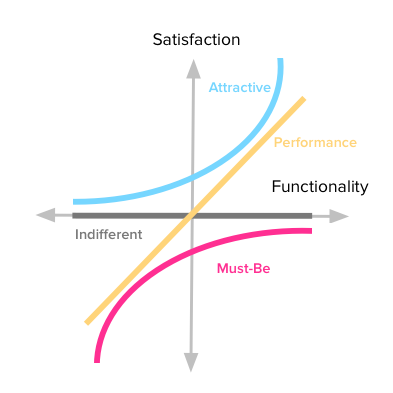Kano model
One of the main goals when starting developing a product or service is to satisfy the customer, but how do you know which features to include and what the customer expect. In order to create competitive product it is of advantage to surprise the customer with not expected features. When starting a product or commissioning a product as a product manager, you have to find out what features should be included. There is a tool to figure it out and to measure satisfaction, it called Kano model. This Article provides an overview, how to use it to find out the requirements, gives an example and represents advantages and disadvantages.
The Kano model is a method to scale the layers of quality and to achieve consumer satisfaction in a project or for a product. The Model was published in 1978 by Noriaki Kano (*1940), a Professor of the Tokyo University of Science. [1] The theory is proposed to understand the relationship between customer satisfaction and quantitative measures. The requirement and the performance of the product or service derive from the different types, the model provides. The model gather the needs of the customers to include them in the development of a product or service. [2] In a product development project it is recommended to use the kano model to meet customer's needs and to determine requirements in an early project phase. The article provides the explanation of the kano model, the application and how to make projects successful by involving it.
Contents |
The five quality elements
The Kano model distinguish five typs of quality elements as followed:
Must-be Quality Elements
are essential and assumed for the customer. If the product does not fulfill these requirements, the customer will be dissatisfied but if it is fulfilled, the customer will not show up satisfaction.
One-dimension Quality Elements
are conscious to the customer, eliminate dissatisfaction or achieve satisfaction depending on the degree of fulfillment, the higher the better.
Attractive Quality Elements
are not usually expected by the customer and do not disappoint them when not fulfilled. These attributes deliver satisfaction or enthusiasm and are the main elements for reaching a competitive advantage. [3]
Indifferent Quality Elements
are not noticed by the customer, they cannot give either satisfaction or dissatisfaction when fulfilled or not.
Reverse Quality Elements
cause satisfaction when absent and dissatisfaction when present. [4]
From Attractive to Must-bo over the time
is today a Must-be, but some years ago they have been Attractive. The quality elements are moving slightly over the time. Todays Must-be, have been Attractive for some years.
Examples
| Produkt Example: Car: |
Service Example: Flight: | |
| Must-be | Breaks, Tires | Seat, Hand-luggage, Seatbelt |
| One-dimension | Horsepower, Fuel consumption, Acceleration | Food and Drinks, Space, Seating width, |
| Attractive | Head-Up Display, TV, Adaptiv chassis | WiFi, Pillow, Blanket, Fresh Towel, Entertainment |
| Indifferent | Supplier of Windows | Design features |
| Reverse | Rusty spots, Flat tires | Canceled Flight, |
| Migration from Attractive to Must-be | ABS, Airbags, Power assisted steering is today a Must-be, but some years ago they have been Attractive. The quality elements are moving slightly over the time. | Früher genügte Bild und Text um den Nutzer zu begeistern (Hauptsache es blinkt), heute ist gutes Design schon fast ein Basismerkmal, auch die Bereitgestellten Datenmengen steigen ständig, was heute noch als "Großzügig" angesehen wird, ist morgen Standard und übermorgen vielleicht sogar ein KO-Kriterium. |
Advantages of the Kano method
In a product or service development it is important to find and to classify customer's needs. The Kano model helps to find and to understand them and to generate the requirements. Better understanding of requirements:
1. The most influenced product criteria on the customer satisfaction can be identified. Dividing product requirements into one-dimension, must-be and attractive dimensions is helpful to decide where to set the focus in the development. For example it is advisable to improve the one-dimension and attractive elements instead of the must-be, which are on a satisfied level. This has more influence on the appreciable product quality and the satisfaction of the customer.
2. The Kano model can be used in tradeoff situations, when two or more product requirements cannot fulfilled at the same time, because of a technical or financial issues. The feature with the higher impact on the customer's satisfaction can be chosen.
3. The requirements vary in customer segments, because of the different expectation to a product. It is possible to work on tailored solution, which provide a high satisfaction level in every segment.
References
- ↑ Kano, N.; Seraku, N.; Takahashi, F.; Tsuji (1984). Attractive Quality and Must-be Quality; Journal of the Japanese Society for Quality Control
- ↑ Hans-Joachim Lenz, Peter-Theodor Wilrich, Wolfgang Schmid (2010). Frontiers in Statistical Quality Control 9. Physica-Verlag Heidelberg, ISBN 978-3-7908-2379-0
- ↑ Brandt, D. R. (1988) How service marketers can ident- ify value-enhancing service elements. Journal of Services Marketing 2, 35–41.
- ↑ D. Randall Brandt, (1988) "HOW SERVICE MARKETERS CAN IDENTIFY VALUE‐ENHANCING SERVICE ELEMENTS", Journal of Services Marketing, Vol. 2 Issue: 3, pp.35-41, https://doi.org/10.1108/eb024732
- ↑ Hinterhuber, H.H., Matzler, K., (1998) How to make product development projects more successful by integrating Kano’s model of customer satisfaction into quality function deployment, Elsevier Science Ltd
